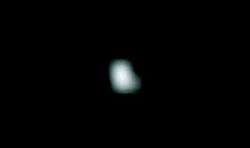132524 APL
 Asteroid 132524 APL seen by New Horizons from 1.34 million kilometers in June 2006 | |
| Discovery [1] | |
|---|---|
| Discovered by | LINEAR |
| Discovery site | Lincoln Lab ETS |
| Discovery date | 9 May 2002 |
| Designations | |
| MPC designation | (132524) APL |
Named after | Applied Physics Laboratory |
| 2002 JF56 | |
| main-belt | |
| Orbital characteristics [1] | |
| Epoch 13 January 2016 (JD 2457400.5) | |
| Uncertainty parameter 0 | |
| Observation arc | 9225 days (25.26 yr) |
| Earliest precovery date | 28 September 1990 |
| Aphelion | 3.3152 AU (495.95 Gm) |
| Perihelion | 1.8897 AU (282.70 Gm) |
| 2.6025 AU (389.33 Gm) | |
| Eccentricity | 0.27388 |
| 4.20 yr (1533.5 d) | |
| 38.076° | |
| 0.23476°/day | |
| Inclination | 4.1593° |
| 51.694° | |
| 262.13° | |
| Physical characteristics | |
Mean diameter | 2.3 km |
| S [2] | |
| 15.4[1] | |
|
| |

New Horizons · (486958) 2014 MU69 · Earth · 132524 APL · Jupiter · Pluto
132524 APL, provisional designation 2002 JF56, is a stony background asteroid in the intermediate asteroid belt, approximately 2.3 kilometers across. It was imaged by the New Horizons space probe on its flyby in 2006.
Description
It was discovered on 9 May 2002 by astronomers of the Lincoln Near-Earth Asteroid Research (LINEAR) at the Lincoln Laboratory's ETS near Socorro, New Mexico, United States.[1] The asteroid orbits the Sun in a somewhat eccentric orbit at a distance of 1.9–3.3 AU once every 4.2 years. Its orbit is tilted off the ecliptic by 4 degrees.[1]
The New Horizons probe flew by it at a distance of approximately 102,000 kilometers on 13 June 2006. The spectra obtained by New Horizons show that APL is a stony S-type asteroid.[2]
New Horizons was not intended to fly by APL, and the flyby was just a coincidence. Alan Stern, principal investigator for New Horizons, named the asteroid in reference to the Johns Hopkins University Applied Physics Laboratory (APL), which runs the mission.[3]
References
- 1 2 3 4 5 "JPL Small-Body Database Browser: 132524 APL (2002 JF56)" (2015-08-22 last obs.). Jet Propulsion Laboratory. Retrieved 26 March 2016.
- 1 2 CBET 547
- ↑ Buckley, Michael (2007-03-05). "APL Rocks! Asteroid Named After JHU Applied Physics Lab". The JHU Gazette. Archived from the original on 30 April 2009. Retrieved 2009-04-20.
Further reading
- Olkin, Catherine B.; Reuter; Lunsford; Binzel; Stern (2006). "The New Horizons Distant Flyby of Asteroid 2002 JF56". Bulletin of the American Astronomical Society. 38: 597. Bibcode:2006DPS....38.5922O.
External links
- Discovery Circumstances: Numbered Minor Planets
- 132524 APL at AstDyS-2, Asteroids—Dynamic Site
- 132524 APL at the JPL Small-Body Database